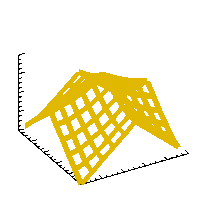A somewhat belated reply to the numerous postings on finding the
common elements of vectors:
> Given vectors of the type...
>
> a = [1,2,3,4,5]
> b = [3,4,5,6,7]
>
> What is the most efficient way to determine which values that occur in
> a also occur in b (i.e., the values [3,4,5] occur in both a and b).
>
Below appear three IDL functions that operate on sets represented by
arrays of positive integers. The SetIntersection(a,b) function
returns the common elements, SetUnion(a,b) returns all unique elements
in both arguments, and SetDifference(a,b) returns the elements
(members) in a but not in b.
It is faster than previously published functions, e.g. contain() and
find_elements().
Hope this helps,
Research Systems, Inc.
____________________________________________________________ _____
; Set operators. Union, Intersection, and Difference (i.e. return
; members of A that are not in B.)
;
; These functions operate on arrays of positive integers, which need
; not be sorted. Duplicate elements are ignored, as they have no
; effect on the result.
;
; The empty set is denoted by an array with the first element equal to
; -1.
;
; These functions will not be efficient on sparse sets with wide
; ranges, as they trade memory for efficiency. The HISTOGRAM function
; is used, which creates arrays of size equal to the range of the
; resulting set.
; For example:
; a = [2,4,6,8]
; b = [6,1,3,2]
; SetIntersection(a,b) = [ 2, 6] ; Common elements
; SetUnion(a,b) = [ 1, 2, 3, 4, 6, 8] ; Elements in either set
; SetDifference(a,b) = [ 4, 8] ; Elements in A but not in B
; SetIntersection(a,[3,5,7]) = -1 = Null Set
FUNCTION SetUnion, a, b
if a[0] lt 0 then return, b ;A union NULL = a
if b[0] lt 0 then return, a ;B union NULL = b
return, where(histogram([a,b], OMIN = omin)) + omin ;Return combined set
end
FUNCTION SetIntersection, a, b
minab = min(a, MAX=maxa) > min(b, MAX=maxb) ;Only need intersection of ranges
maxab = maxa < maxb
;If either set is empty, or their ranges don't intersect: result = NULL.
if maxab lt minab or maxab lt 0 then return, -1
r = where((histogram(a, MIN=minab, MAX=maxab) ne 0) and $
(histogram(b, MIN=minab, MAX=maxab) ne 0), count)
if count eq 0 then return, -1 else return, r + minab
end
FUNCTION SetDifference, a, b ; = a and (not b) = elements in A but not
in B
mina = min(a, MAX=maxa)
minb = min(b, MAX=maxb)
if (minb gt maxa) or (maxb lt mina) then return, a ;No intersection...
r = where((histogram(a, MIN=mina, MAX=maxa) ne 0) and $
(histogram(b, MIN=mina, MAX=maxa) eq 0), count)
if count eq 0 then return, -1 else return, r + mina
end
|
 comp.lang.idl-pvwave archive
comp.lang.idl-pvwave archive








 Members
Members Search
Search Help
Help Login
Login Home
Home




